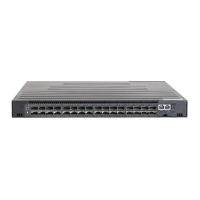C
HAPTER
14
| Basic Administration Protocols
OAM Configuration
– 549 –
OAM CONFIGURATION
The switch provides OAM (Operation, Administration, and Maintenance)
remote management tools required to monitor and maintain the links to
subscriber CPEs (Customer Premise Equipment). This section describes
functions including enabling OAM for selected ports, loopback testing, and
displaying remote device information.
ENABLING OAM ON
LOCAL PORTS
Use the Administration > OAM > Interface page to enable OAM
functionality on the selected port. Not all CPEs support operation and
maintenance functions, so OAM is therefore disabled by default. If a CPE
supports OAM, this functionality must first be enabled on the connected
port to gain access to the configuration functions provided under the OAM
menu.
CLI REFERENCES
◆ "OAM Commands" on page 1353
PARAMETERS
These parameters are displayed:
◆ Port – Port identifier. (Range: 1-28/52)
◆ Admin Status – Enables or disables OAM functions.
(Default: Disabled)
◆ Operation State – Shows the operational state between the local and
remote OAM devices. This value is always “disabled” if OAM is disabled
on the local interface.
Table 35: OAM Operation State
State Description
Disabled OAM is disabled on this interface via the OAM Admin Status.
Link Fault The link has detected a fault or the interface is not operational.
Passive Wait
This value is returned only by OAM entities in passive mode and
indicates
the OAM entity is waiting to see if the peer device is
OAM capable.
Active Send Local This value is used by active mode devices and indicates the
OAM entity is actively trying to discover whether the peer has
OAM capability but has not yet made that determination.
Send Local And Remote The local OAM entity has discovered the peer but has not yet
accepted or rejected the configuration of the peer.
Send Local And Remote
OK
OAM peering is allowed by the local device.
OAM Peering Locally
Rejected
The local OAM entity rejects the peering.
OAM Peering Remotely
Rejected
The remote OAM entity rejects the peering.

